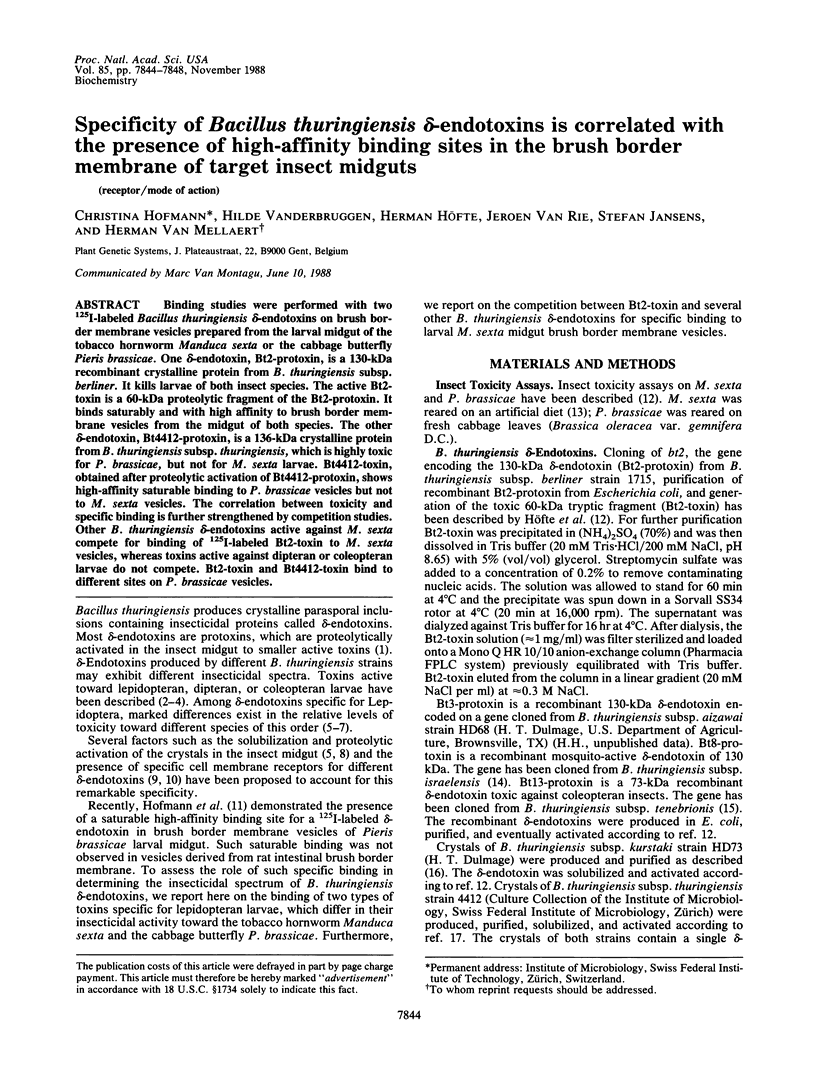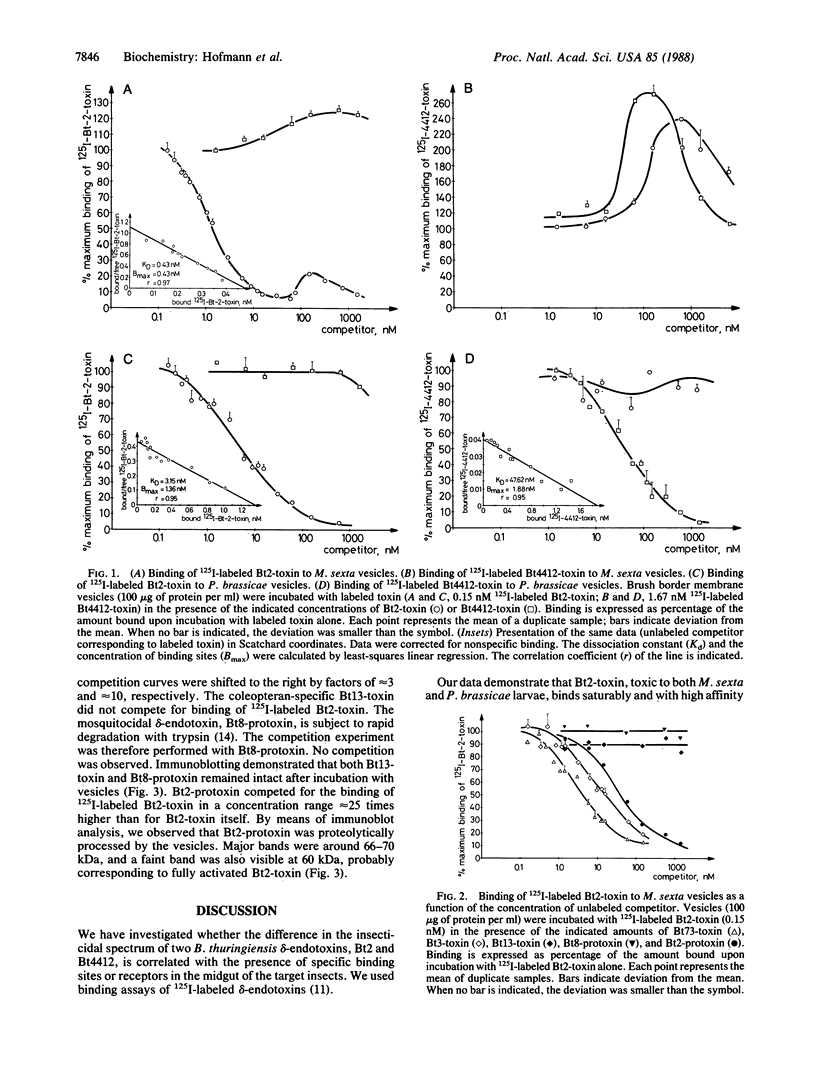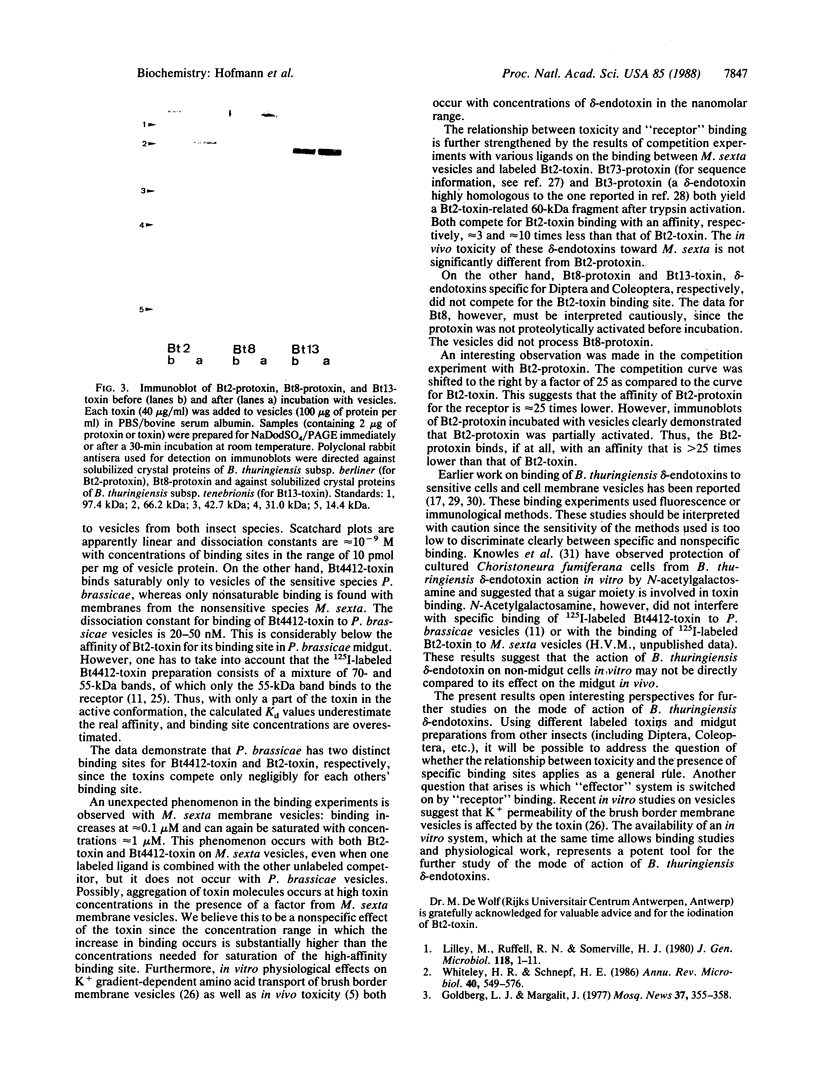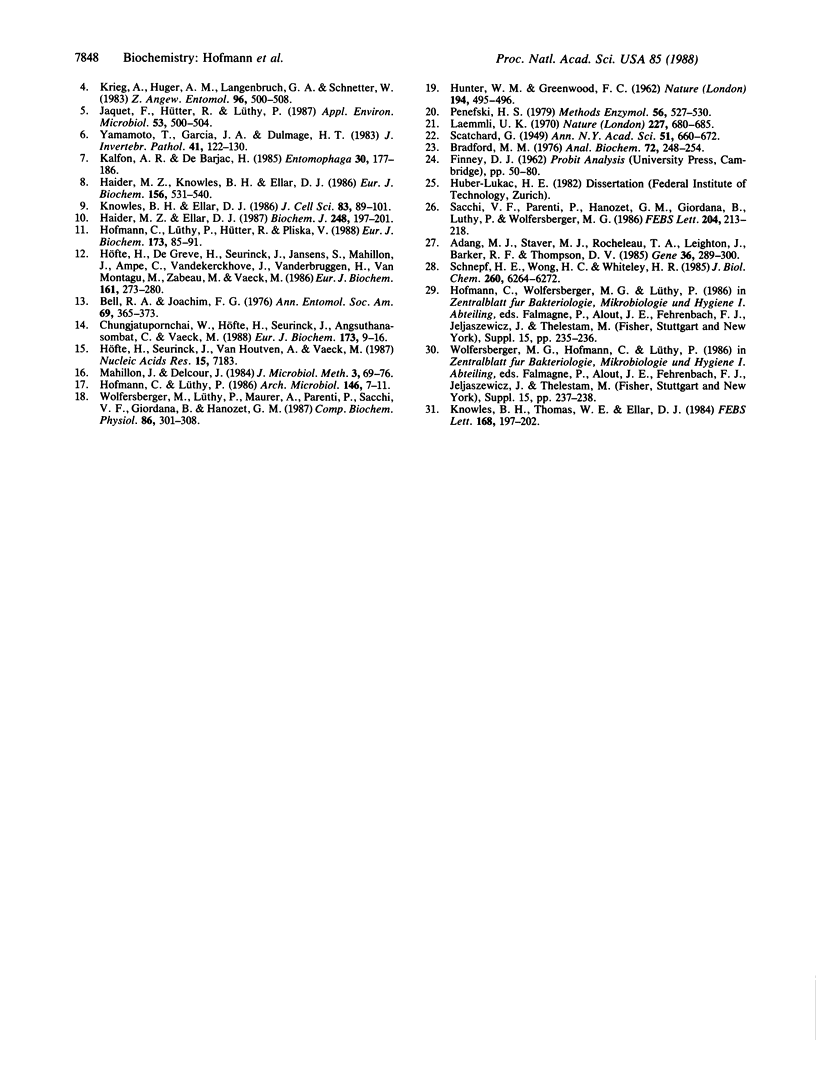Abstract
Binding studies were performed with two 125I-labeled Bacillus thuringiensis delta-endotoxins on brush border membrane vesicles prepared from the larval midgut of the tobacco hornworm Manduca sexta or the cabbage butterfly Pieris brassicae. One delta-endotoxin, Bt2-protoxin, is a 130-kDa recombinant crystalline protein from B. thuringiensis subsp. berliner. It kills larvae of both insect species. The active Bt2-toxin is a 60-kDa proteolytic fragment of the Bt2-protoxin. It binds saturably and with high affinity to brush border membrane vesicles from the midgut of both species. The other delta-endotoxin, Bt4412-protoxin, is a 136-kDa crystalline protein from B. thuringiensis subsp. thuringiensis, which is highly toxic for P. brassicae, but not for M. sexta larvae. Bt4412-toxin, obtained after proteolytic activation of Bt4412-protoxin, shows high-affinity saturable binding to P. brassicae vesicles but not to M. sexta vesicles. The correlation between toxicity and specific binding is further strengthened by competition studies. Other B. thuringiensis delta-endotoxins active against M. sexta compete for binding of 125I-labeled Bt2-toxin to M. sexta vesicles, whereas toxins active against dipteran or coleopteran larvae do not compete. Bt2-toxin and Bt4412-toxin bind to different sites on P. brassicae vesicles.
Full text
PDF




Images in this article
Selected References
These references are in PubMed. This may not be the complete list of references from this article.
- Adang M. J., Staver M. J., Rocheleau T. A., Leighton J., Barker R. F., Thompson D. V. Characterized full-length and truncated plasmid clones of the crystal protein of Bacillus thuringiensis subsp. kurstaki HD-73 and their toxicity to Manduca sexta. Gene. 1985;36(3):289–300. doi: 10.1016/0378-1119(85)90184-2. [DOI] [PubMed] [Google Scholar]
- Bradford M. M. A rapid and sensitive method for the quantitation of microgram quantities of protein utilizing the principle of protein-dye binding. Anal Biochem. 1976 May 7;72:248–254. doi: 10.1016/0003-2697(76)90527-3. [DOI] [PubMed] [Google Scholar]
- Chungjatupornchai W., Höfte H., Seurinck J., Angsuthanasombat C., Vaeck M. Common features of Bacillus thuringiensis toxins specific for Diptera and Lepidoptera. Eur J Biochem. 1988 Apr 5;173(1):9–16. doi: 10.1111/j.1432-1033.1988.tb13960.x. [DOI] [PubMed] [Google Scholar]
- HUNTER W. M., GREENWOOD F. C. Preparation of iodine-131 labelled human growth hormone of high specific activity. Nature. 1962 May 5;194:495–496. doi: 10.1038/194495a0. [DOI] [PubMed] [Google Scholar]
- Haider M. Z., Ellar D. J. Analysis of the molecular basis of insecticidal specificity of Bacillus thuringiensis crystal delta-endotoxin. Biochem J. 1987 Nov 15;248(1):197–201. doi: 10.1042/bj2480197. [DOI] [PMC free article] [PubMed] [Google Scholar]
- Haider M. Z., Knowles B. H., Ellar D. J. Specificity of Bacillus thuringiensis var. colmeri insecticidal delta-endotoxin is determined by differential proteolytic processing of the protoxin by larval gut proteases. Eur J Biochem. 1986 May 2;156(3):531–540. doi: 10.1111/j.1432-1033.1986.tb09612.x. [DOI] [PubMed] [Google Scholar]
- Hofmann C., Lüthy P. Binding and activity of Bacillus thuringiensis delta-endotoxin to invertebrate cells. Arch Microbiol. 1986 Oct;146(1):7–11. doi: 10.1007/BF00690150. [DOI] [PubMed] [Google Scholar]
- Hofmann C., Lüthy P., Hütter R., Pliska V. Binding of the delta endotoxin from Bacillus thuringiensis to brush-border membrane vesicles of the cabbage butterfly (Pieris brassicae). Eur J Biochem. 1988 Apr 5;173(1):85–91. doi: 10.1111/j.1432-1033.1988.tb13970.x. [DOI] [PubMed] [Google Scholar]
- Höfte H., Seurinck J., Van Houtven A., Vaeck M. Nucleotide sequence of a gene encoding an insecticidal protein of Bacillus thuringiensis var. tenebrionis toxic against Coleoptera. Nucleic Acids Res. 1987 Sep 11;15(17):7183–7183. doi: 10.1093/nar/15.17.7183. [DOI] [PMC free article] [PubMed] [Google Scholar]
- Höfte H., de Greve H., Seurinck J., Jansens S., Mahillon J., Ampe C., Vandekerckhove J., Vanderbruggen H., van Montagu M., Zabeau M. Structural and functional analysis of a cloned delta endotoxin of Bacillus thuringiensis berliner 1715. Eur J Biochem. 1986 Dec 1;161(2):273–280. doi: 10.1111/j.1432-1033.1986.tb10443.x. [DOI] [PubMed] [Google Scholar]
- Jaquet F., Hütter R., Lüthy P. Specificity of Bacillus thuringiensis Delta-Endotoxin. Appl Environ Microbiol. 1987 Mar;53(3):500–504. doi: 10.1128/aem.53.3.500-504.1987. [DOI] [PMC free article] [PubMed] [Google Scholar]
- Knowles B. H., Ellar D. J. Characterization and partial purification of a plasma membrane receptor for Bacillus thuringiensis var. kurstaki lepidopteran-specific delta-endotoxin. J Cell Sci. 1986 Jul;83:89–101. doi: 10.1242/jcs.83.1.89. [DOI] [PubMed] [Google Scholar]
- Knowles B. H., Thomas W. E., Ellar D. J. Lectin-like binding of Bacillus thuringiensis var. kurstaki lepidopteran-specific toxin is an initial step in insecticidal action. FEBS Lett. 1984 Mar 26;168(2):197–202. doi: 10.1016/0014-5793(84)80245-8. [DOI] [PubMed] [Google Scholar]
- Laemmli U. K. Cleavage of structural proteins during the assembly of the head of bacteriophage T4. Nature. 1970 Aug 15;227(5259):680–685. doi: 10.1038/227680a0. [DOI] [PubMed] [Google Scholar]
- Lilley M., Ruffell R. N., Somerville H. J. Purification of the insecticidal toxin in crystals of Bacillus thuringiensis. J Gen Microbiol. 1980 May;118(1):1–11. doi: 10.1099/00221287-118-1-1. [DOI] [PubMed] [Google Scholar]
- Penefsky H. S. A centrifuged-column procedure for the measurement of ligand binding by beef heart F1. Methods Enzymol. 1979;56:527–530. doi: 10.1016/0076-6879(79)56050-9. [DOI] [PubMed] [Google Scholar]
- Schnepf H. E., Wong H. C., Whiteley H. R. The amino acid sequence of a crystal protein from Bacillus thuringiensis deduced from the DNA base sequence. J Biol Chem. 1985 May 25;260(10):6264–6272. [PubMed] [Google Scholar]
- Whiteley H. R., Schnepf H. E. The molecular biology of parasporal crystal body formation in Bacillus thuringiensis. Annu Rev Microbiol. 1986;40:549–576. doi: 10.1146/annurev.mi.40.100186.003001. [DOI] [PubMed] [Google Scholar]



